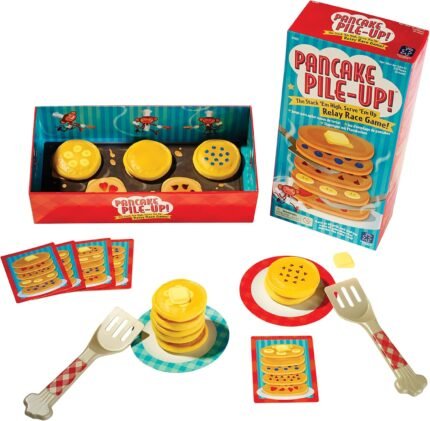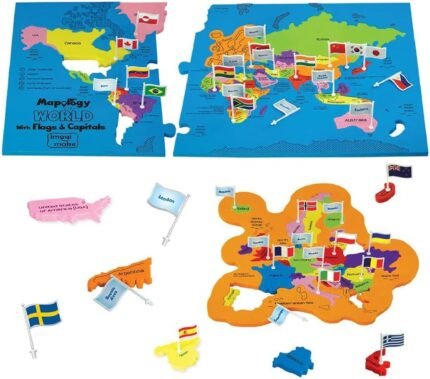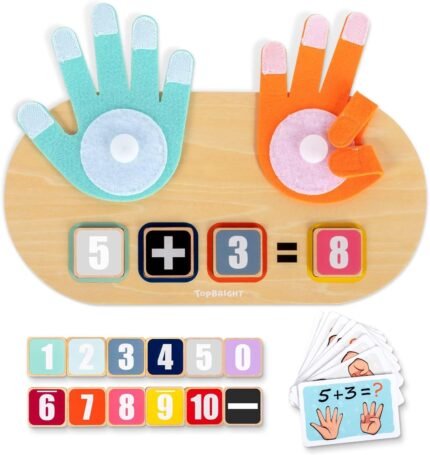Learning Resources Mini ABC Pops – Alphabet Learning Toys, ABC Puzzle, Phonics Games for Toddlers, Fine Motor Toys, Play Food Set, Preschool Learning Activities, Sensory Bin Letters, Gifts for Kids
$19.99 Original price was: $19.99.$12.59Current price is: $12.59.




Discover the joy of early literacy with Learning Resources’ Mini ABC Pops! These colorful popsicle-shaped toys transform alphabet learning into a delightful hands-on experience perfect for little learners. Each of the 26 mini pops features an uppercase letter on its colorful outer shell, which children can pop off to reveal a matching lowercase letter and illustrated vocabulary word inside, reinforcing letter recognition and phonics in one playful motion. Designed specifically for preschoolers, these pops do more than teach letters—they develop crucial fine motor skills as children grasp, twist, and manipulate each piece. The satisfying “pop” action engages children’s senses while they practice matching letters to beginning sounds, creating a multi-sensory learning experience that helps information stick. The set comes complete with a reusable storage jar that makes cleanup simple and storage convenient, perfect for classrooms, homeschool settings, or everyday play. The durable, plastic construction ensures these educational toys will withstand enthusiastic play session after session. Mini ABC Pops align beautifully with Montessori principles by encouraging self-directed, hands-on learning at the child’s own pace. Whether used for structured alphabet activities or imaginative play scenarios like ice cream shops, these versatile tools keep children engaged while building essential pre-reading skills. Since 1984, Learning Resources has created educational toys that combine fun with fundamental learning, helping children develop crucial skills through screen-free play. The Mini ABC Pops continue this tradition, turning alphabet practice into a sweet learning adventure that children will reach for again and again.
LETTER RECOGNITION – Develop essential early literacy skills through colorful, hands-on play with 26 popsicle-shaped letter pieces that feature uppercase letters on top and matching lowercase letters with pictures underneath.
MULTI-LEARNING APPROACH – Engage children with multiple educational concepts including color matching, letter recognition, vocabulary building, and phonics
FINE MOTOR DEVELOPMENT – Strengthen little fingers and improve hand-eye coordination as children pop tops on and off, sort popsicles, and match corresponding letters and pictures.
VERSATILE PLAY VALUE – Extend beyond basic alphabet learning into imaginative play scenarios like ice cream shops, picnics, or kitchen pretend play, making learning feel like a fun lesson.
DURABLE CLASSROOM QUALITY – Made from high-quality, child-safe materials designed to withstand enthusiastic daily use while coming in a convenient storage container that keeps all 52 pieces organized.












GJ –
Great learning toy
Excellent educational activity and toy my two-year-old will sit with me and focus and learn something with these and has a blast!
Maranda –
Highly motivating
My students have been playing with these letter matching toys all year. Highly motivating and engaging materials. Washable. Durable. Fun. Colorful.
Amazon Customer –
Fun for toddlers
Just shows that small children donât need a lot of bells and whistles to be entertained. My granddaughter who is two absolutely loves the âalphabet ice pops.â And she is learning as she plays
The One-Click Wonders –
Durable and vibrant.
Good quality and the bin offers as storage. My 6yr old got bored of them very quickly so I ultimately returned them.
Jose A. –
Good quality and functional
The letters and the words inside are big enough to be read by a little kid, the material is durable and they are easy to use because each word has an image. Very functional.
Hannah –
Great educational toy
I love these for pretend play and as your child gets older you can match the letters to words. My children love them! They are durable and great for playing and educating.
Marissa B –
Educational and fun
Love this! My boys love it too. Dual purpose, they match the numbers for an educational portion and use the cookies in their pretend kitchen to make cookies when they play bake shop. Easy to clean by running through the dishwasher or washing machine in a mesh bag. Will be great to bring outside in the summer to play in the water table due to their high quality and durability. Cookies are just the right size for smaller hands and easy to manipulate while adding a fine motor component.
Natalie B. –
Great toddler gift
My son loved these. He’s obsessed with Icecream and this is his favorite so far.
Amazon Customer –
Cute christmas gift, great for learning.
Alannah Willis –
My 3 year old loves these. They are a great way to learn and play at the same time. We like to mix up the letters with the words and then find their missing match.
Sandra –
Material visual, lúdico y motivador para aprender la numeración del 1 al 20. A mis peques les encanta.
Amazon Customer –
Really great learning tool. My grandson was engaged as soon as we opened it. Well made, colourful. Can be used in many different, fun ways.
Susi –
Die Mini-Zahlenkekse wurden in einem Plastikeimer mit Deckel geliefert und entsprechen den Produktbildern.Den Eimer finde ich eigentlich praktisch, allerdings hätte ein halb so groÃer auch gereicht, aber vermutlich gibt es nur bestimmte StandardmaÃe. Innen liegt nämlich ein Platzhalter und entfernt man diesen, ist der Eimer nur noch halb gefüllt. Das ist schon ein wenig Kundentäuschung. Eine andere Verpackungsart hätte es auch getan, z.B. eine Pappschachtel. Oder man hätte noch mehr Teile hinzugefügt, dann hätte sich der Eimer gelohnt.Zum Lernspiel selbst: Es handelt sich um “Kekse”, die aus zwei Teilen zusammengesetzt werden sollen. Auf der einen Seite stehen die Zahlen von 1-20, auf der anderen sind Mengen abgedruckt. Ich habe das Spiel heute Vormittag mit meinen Erstklässlern ausprobiert, die gerade den Zahlenraum bis 20 erkunden. Pfiffige Kinder orientieren sich an den Farben. Immerhin gibt es mehrere Kekse mit der gleichen Farbe, sodass zumindest ein bisschen gezählt werden muss. Fittere Kinder zählen jedoch nicht, sondern können die Mengen vergleichen und mit einem kurzen Blick abschätzen, ob die Menge zur gröÃeren oder kleineren Zahl mit derselben Farbe gehört. Die abgebildeten Mengen sind dabei auch nicht immer für die Kids überschaubar oder in Teilmengen gliederbar, sodass sie durchaus zählen müssen, was ja eigentlich von mir so gewollt ist. Aber auch dass die fitteren Kinder ihre Strategien verfolgen, ist natürlich in Ordnung. So kann jeder auf seinem Niveau mit dem Material umgehen.Ich bin mir noch nicht so ganz mit mir selbst einig, ob ich es nicht besser gefunden hätte, ähnliche Mengen in derselben Farbe zu haben, statt Mengen mit groÃen Unterschieden. Z.B. sind 3, 8, 13 und 18 grün. Okay, 13 und 18 liegen noch recht nah beieinander und müssen eher gezählt werden, aber die anderen beiden sind schon recht deutlich unterscheidbar, ohne viel zählen zu müssen. Vielleicht hätte ich es besser gefunden, wenn z.B. alle Zahlen von 1-5 die gleiche Farbe hätten, dann von 6-10, usw., damit die Kids noch mehr zählen müssen. Dann müsste man eben als Lehrer nachträglich mehr kontrollieren. So, wie es jetzt ist, dienen die Farben ja eher der Selbstkontrolle, was zwar gut für die Kinder ist, aber gleichzeitig stecken manche eben eher die passenden Farben zusammen als wirklich genau auf die Mengen zu achten. Immerhin zählen einige Kinder trotzdem und können dann anhand der Farbe selbst kontrollieren, ob es stimmt. So ist es ja eigentlich auch gedacht. Die Kinder, die nicht zählen, können ja auch dazu angehalten werden. Für eine noch bessere Selbstkontrolle wäre es vielleicht auch gut, wenn nicht alle Kekshälften zusammenpassen würden, sondern nur die, die zusammengehören. Aber selbst dann gibt es vermutlich Kinder, die sich an der Form der Kekse orientieren statt an den Mengen und Zahlen. So oder so sollte man als Erwachsener also immer ein Auge darauf haben.Es liegt auch ein Blättchen mit Spielvorschlägen bei, die selbst schon die Kleinsten spielen können (mit entsprechend weniger Keksen oder eher auf Farben und Mengen statt auf Zahlbilder fokussiert). Es gibt aber noch weitaus mehr Möglichkeiten.Z.B. eignen sich die Zahlenkekse auch für Partner- und Kleingruppenspiele. Z.B. können die Zahlenhälften aufgeteilt werden und die Mengenhälften werden offen oder umgedreht in die Mitte gelegt. Nun wird abwechselnd gezogen und wenn eine Menge zur eigenen Zahl passt, darf man sie zusammenstecken.Die Kekse können auch sortiert werden, mit Suchaufträgen (Welche Zahl liegt zwischen 13 und 15?, Welche Zahl kommt nach 7?, …). Oder einer schlieÃt die Augen und der andere nimmt einen Keks weg bzw. vertauscht zwei Kekse. Das erste Kind muss dann den fehlenden/vertauschten Keks erraten.Insgesamt gefällt mir das Spiel sehr und die Kinder lieben es. Sie beschäftigten sich heute sehr intensiv damit, zählten fleiÃig und hatten Vergnügen. Damit ist für mich das Ziel erreicht. Ich kann das Spiel auf jeden Fall weiterempfehlen und gebe trotz der genannten Kleinigkeiten noch fünf Sterne.